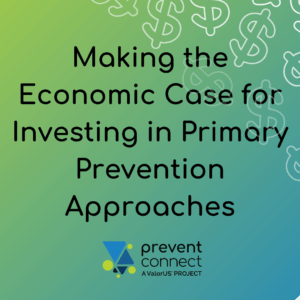Making the Economic Case for Investing in Primary Prevention Approaches
 For decades, sexual violence prevention practitioners have been calling for greater investment in preventing child sexual abuse. They’ve emphasized the importance of stopping harm before it happens, of supporting families and communities, and of changing the conditions that allow abuse to persist. Yet, one of the most persistent challenges facing preventionists is the lack of economic evidence to show that prevention is not only effective but it’s also worth the cost.
For decades, sexual violence prevention practitioners have been calling for greater investment in preventing child sexual abuse. They’ve emphasized the importance of stopping harm before it happens, of supporting families and communities, and of changing the conditions that allow abuse to persist. Yet, one of the most persistent challenges facing preventionists is the lack of economic evidence to show that prevention is not only effective but it’s also worth the cost.
A new article, Economic Evaluation of Prevention Interventions for Child Sexual Exploitation or Child Sexual Abuse: A Systematic Review, aims to change that. Published in 2024, the review synthesizes available research on the cost-effectiveness of prevention interventions and makes a clear call for more attention to the financial value of investing in prevention especially at the community level.
Prevention Saves Money—But Where’s the Data?
The review analyzed 17 studies that included some form of economic evaluation of interventions targeting child sexual abuse or exploitation. Most of the studies were conducted in high-income countries like the United States, Australia, and the United Kingdom. While the findings were generally positive, showing that many interventions were either cost-effective or cost-saving, the bulk of the research focused on tertiary prevention – the long-term responses after violence has already occurred to address the lasting consequences of violence.
Only two studies looked at primary prevention. Those studies measured cost, but not outcomes, meaning there is still limited understanding of how much these interventions reduce abuse in the long term.
Without more data on community-level primary prevention, it remains difficult to show policymakers and funders that prevention is a smart, sustainable investment. Yet, as this review emphasizes, the costs of inaction are staggering, both in terms of the public systems that must respond to harm and the lifelong impacts on individuals, families, and communities.
Cost-Effectiveness Can Strengthen the Case for Prevention
Preventionists often struggle to convince stakeholders to dedicate time, funding, and attention to upstream efforts. The question is not whether prevention is important – most agree that it is – but whether it’s “worth it.” This review provides important context for answering that question.
Among the studies reviewed:
- Some found that for every dollar spent on a program, tens or even hundreds of dollars were saved down the line through avoided criminal legal, health care, and social service costs.
- Programs for children who had already experienced abuse were shown to reduce trauma-related symptoms and improve functioning at relatively low cost.
- Community-based treatment programs for juvenile offenders were significantly less expensive than incarceration and appeared to reduce recidivism.
Still, most studies focused narrowly on direct costs like staffing, materials, and physical space, and did not consistently account for broader, harder-to-measure impacts like pain, suffering, or lost opportunities for children and families. These intangible costs can be substantial, and omitting them may significantly underestimate the true value of prevention.
Organizations like the Moore Center for the Prevention of Child Sexual Abuse at Johns Hopkins University have long championed the importance of economic research in prevention. The Moore Center states: “Investing in the prevention of child sexual abuse is dollar for dollar, the most effective investment in the potential and prosperity of future generations.” Their commitment to making the investment case is reflected in several key reports and articles that help bridge the gap between research and policy. These resources, available on their website, offer important context for how prevention programs can generate cost savings while also protecting children and strengthening communities.
A Call for More Research on What Works
One of the paper’s most important takeaways is that the economic evidence for primary (before violence happens) and secondary (efforts immediately following violence to reduce further harm) prevention is still lacking. While many community-based programs aim to build protective factors, reduce risk, and prevent abuse before it starts, few have been evaluated through an economic lens. And even fewer have data that clearly tie costs to outcomes.
Public health approaches to violence prevention may be key to long-term change, but without economic evaluation, these efforts risk being seen as optional, rather than essential.
The authors of the paper call for:
- More rigorous studies of primary and secondary prevention, especially those targeting general and at-risk populations.
- Consistent reporting of costs—including indirect and intangible costs.
- Broader inclusion of population samples across communities and settings.
Moving Forward
This paper doesn’t answer every question, but it highlights an urgent need to better understand and clearly communicate the economic benefits of prevention. As public health and violence prevention professionals continue to advocate for upstream approaches, cost-effectiveness data can help strengthen the case with decision-makers, funders, and other partners.
At its core, prevention is about creating conditions where children are safe, families are supported, and harm is less likely to happen in the first place. It’s also, increasingly, a sound financial strategy. Investing in prevention means investing in safer, healthier, and more resilient communities.
